lock SSANGYONG TURISMO 2013 Manual PDF
[x] Cancel search | Manufacturer: SSANGYONG, Model Year: 2013, Model line: TURISMO, Model: SSANGYONG TURISMO 2013Pages: 796, PDF Size: 78.99 MB
Page 651 of 796
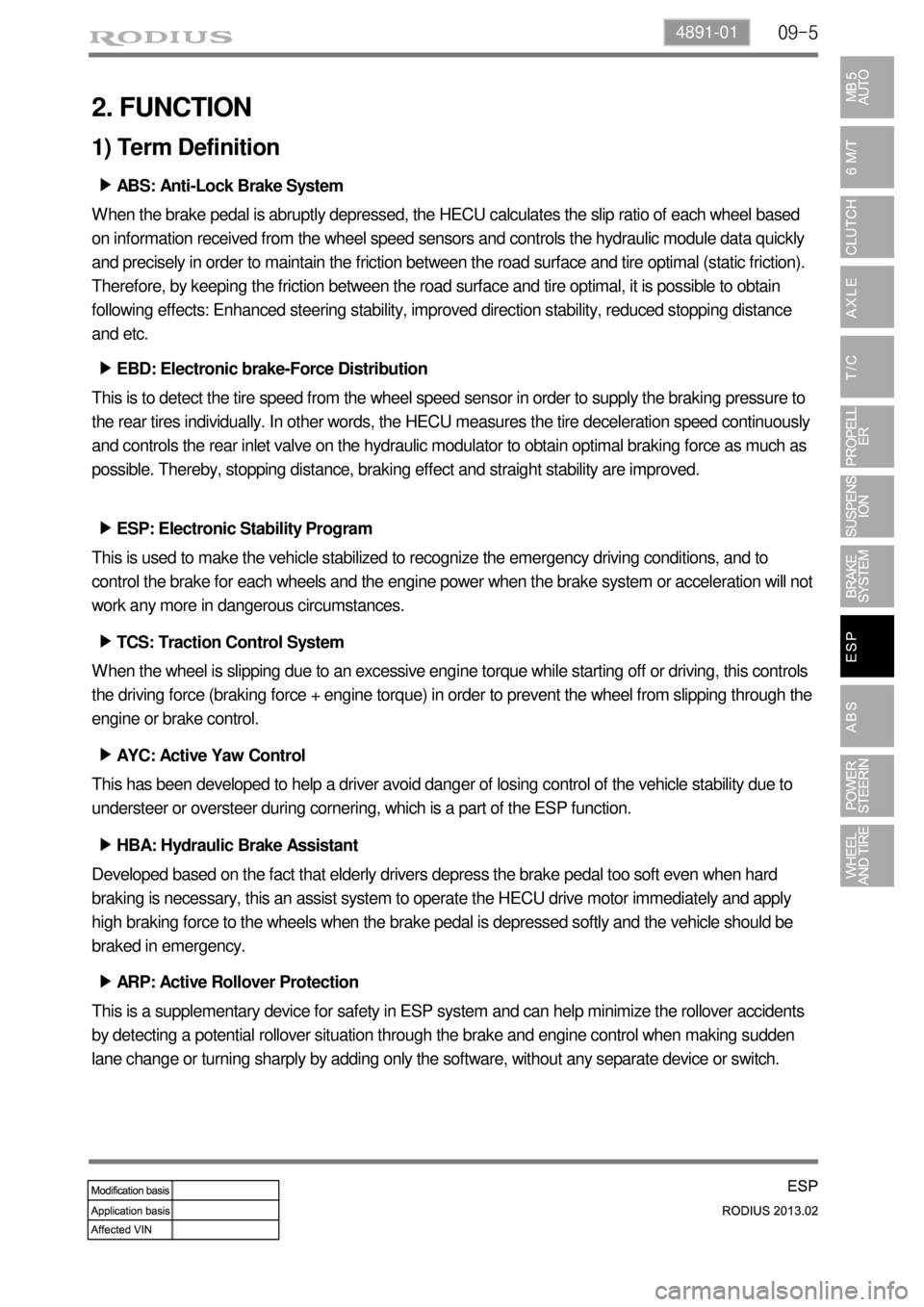
09-54891-01
2. FUNCTION
1) Term Definition
ABS: Anti-Lock Brake System ▶
When the brake pedal is abruptly depressed, the HECU calculates the slip ratio of each wheel based
on information received from the wheel speed sensors and controls the hydraulic module data quickly
and precisely in order to maintain the friction between the road surface and tire optimal (static friction).
Therefore, by keeping the friction between the road surface and tire optimal, it is possible to obtain
following effects: Enhanced steering stability, improved direction stability, reduced stopping distance
and etc.
EBD: Electronic brake-Force Distribution ▶
This is to detect the tire speed from the wheel speed sensor in order to supply the braking pressure to
the rear tires individually. In other words, the HECU measures the tire deceleration speed continuously
and controls the rear inlet valve on the hydraulic modulator to obtain optimal braking force as much as
possible. Thereby, stopping distance, braking effect and straight stability are improved.
ESP: Electronic Stability Program ▶
This is used to make the vehicle stabilized to recognize the emergency driving conditions, and to
control the brake for each wheels and the engine power when the brake system or acceleration will not
work any more in dangerous circumstances.
TCS: Traction Control System ▶
When the wheel is slipping due to an excessive engine torque while starting off or driving, this controls
the driving force (braking force + engine torque) in order to prevent the wheel from slipping through the
engine or brake control.
AYC: Active Yaw Control ▶
This has been developed to help a driver avoid danger of losing control of the vehicle stability due to
understeer or oversteer during cornering, which is a part of the ESP function.
HBA: Hydraulic Brake Assistant ▶
Developed based on the fact that elderly drivers depress the brake pedal too soft even when hard
braking is necessary, this an assist system to operate the HECU drive motor immediately and apply
high braking force to the wheels when the brake pedal is depressed softly and the vehicle should be
braked in emergency.
ARP: Active Rollover Protection ▶
This is a supplementary device for safety in ESP system and can help minimize the rollover accidents
by detecting a potential rollover situation through the brake and engine control when making sudden
lane change or turning sharply by adding only the software, without any separate device or switch.
Page 658 of 796

09-12
3. OPERATING PROCESS
1) Block Diagram of Input and Output
Page 669 of 796

09-234891-01
(2) Hydraulic Circuit of HBA
The above figure shows one front and one rear wheel and the same hydraulic circuit forms as in the
ESP operation. When HECU recognizes that it is an emergency and it is required for hard braking,
depending on the pressure value of the brake pressure sensor and pressure changes caused by the
pressure sensor timing, it operates the pump immediately to apply the brake pressure at the wheels.
Then, the pressure in the pump increases until just before the corresponding wheel gets locked. The
motor still keeps rotating and the outlet valve and the separation valve will stay closed. When the wheel
starts to lock, the HBA function cancels and switches to ABS operation.
Page 671 of 796

09-254891-01
▶DUMP (ESP is working) Mode
The pressure decreases just before the wheel speed drops and the wheels are locked.
The inlet valve closes and the outlet valve opens as in the ESP HECU and the oil is gathered at the
low pressure chamber while no additional oil is being supplied. Then the pump operates to allow fast oil
drainage. The shuttle valve and the separation valve do not operate while decompression.
Page 673 of 796
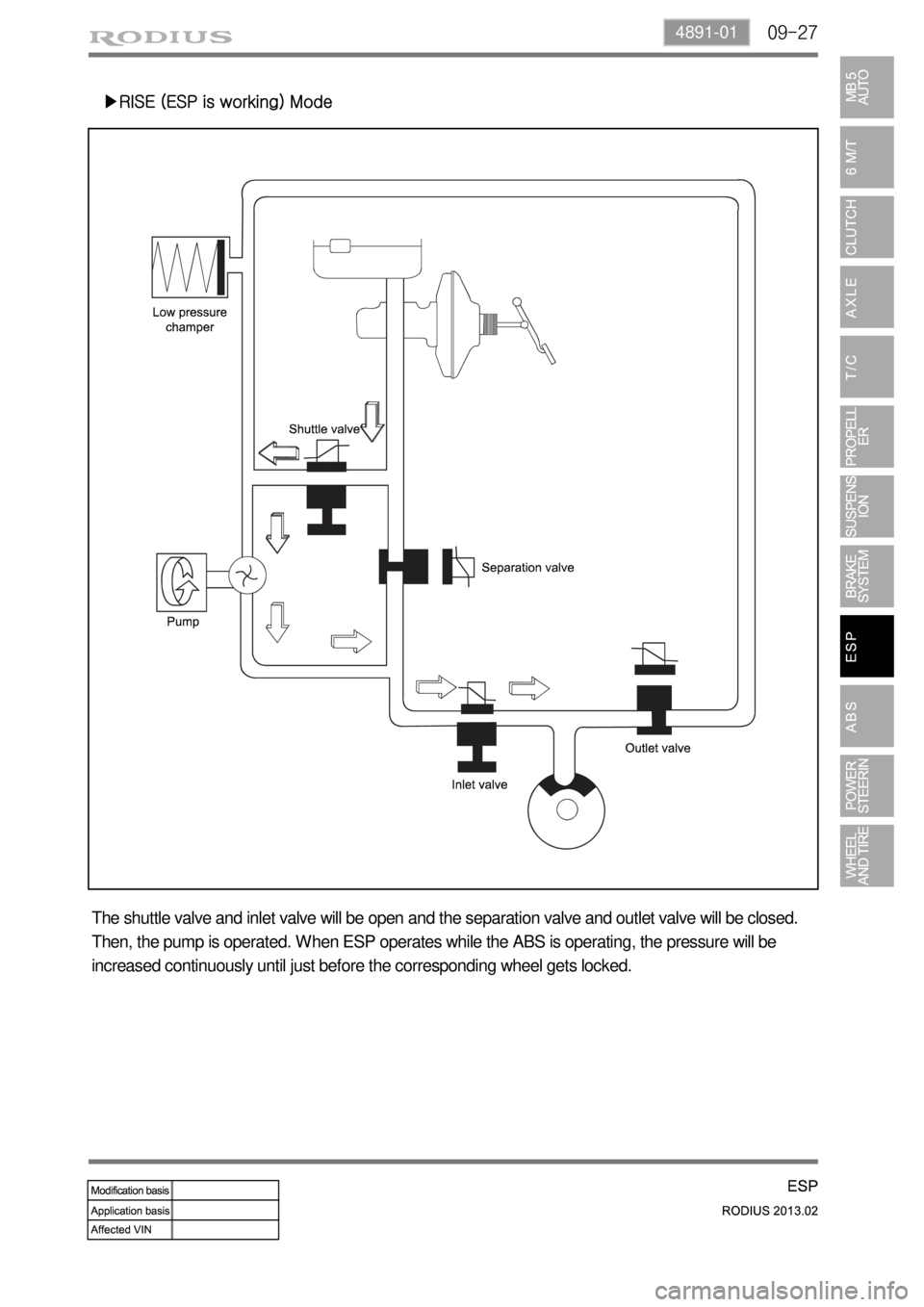
09-274891-01
▶RISE (ESP is working) Mode
The shuttle valve and inlet valve will be open and the separation valve and outlet valve will be closed.
Then, the pump is operated. When ESP operates while the ABS is operating, the pressure will be
increased continuously until just before the corresponding wheel gets locked.
Page 676 of 796
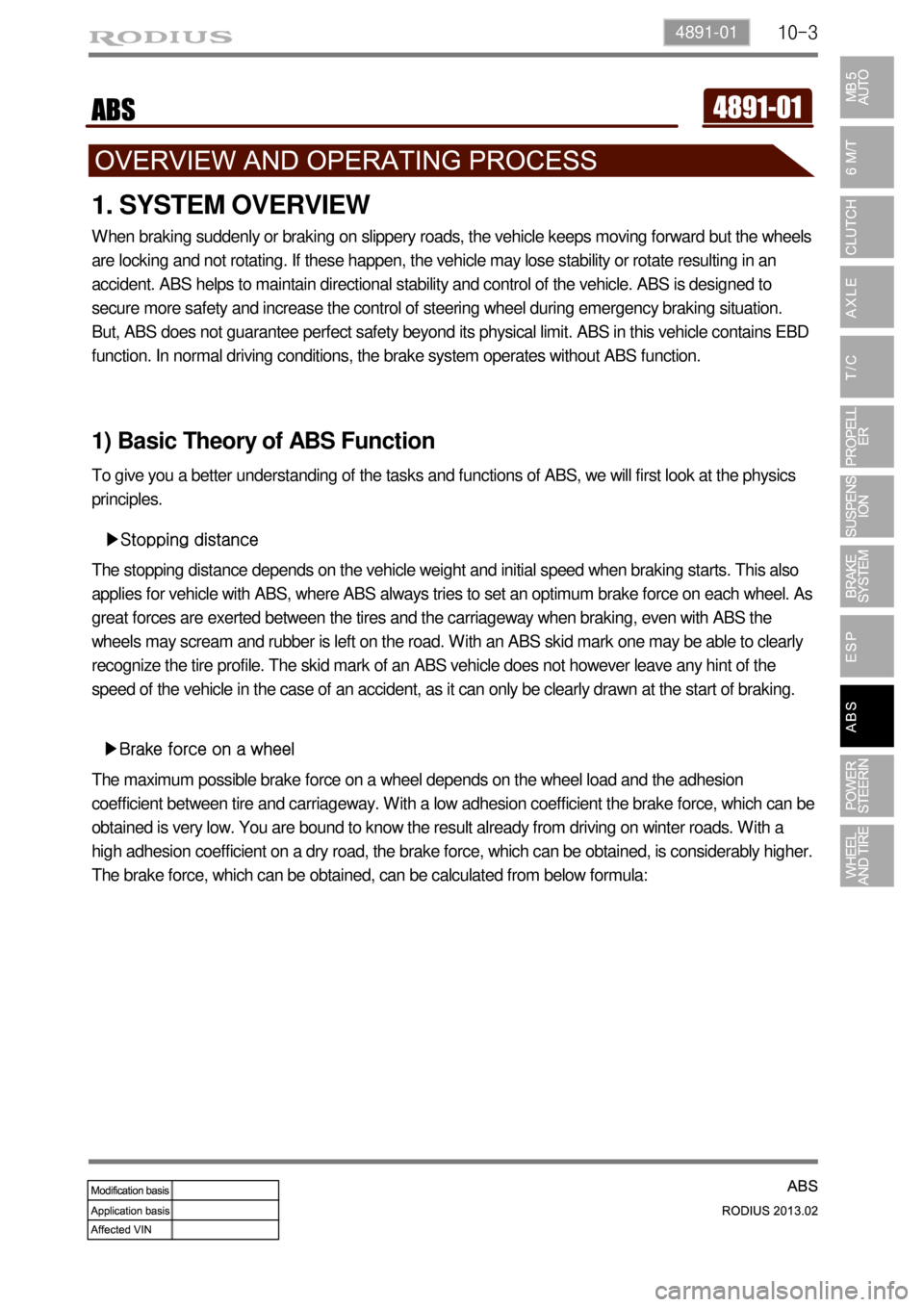
10-34891-01
1. SYSTEM OVERVIEW
When braking suddenly or braking on slippery roads, the vehicle keeps moving forward but the wheels
are locking and not rotating. If these happen, the vehicle may lose stability or rotate resulting in an
accident. ABS helps to maintain directional stability and control of the vehicle. ABS is designed to
secure more safety and increase the control of steering wheel during emergency braking situation.
But, ABS does not guarantee perfect safety beyond its physical limit. ABS in this vehicle contains EBD
function. In normal driving conditions, the brake system operates without ABS function.
1) Basic Theory of ABS Function
To give you a better understanding of the tasks and functions of ABS, we will first look at the physics
principles.
▶Stopping distance
The stopping distance depends on the vehicle weight and initial speed when braking starts. This also
applies for vehicle with ABS, where ABS always tries to set an optimum brake force on each wheel. As
great forces are exerted between the tires and the carriageway when braking, even with ABS the
wheels may scream and rubber is left on the road. With an ABS skid mark one may be able to clearly
recognize the tire profile. The skid mark of an ABS vehicle does not however leave any hint of the
speed of the vehicle in the case of an accident, as it can only be clearly drawn at the start of braking.
▶Brake force on a wheel
The maximum possible brake force on a wheel depends on the wheel load and the adhesion
coefficient between tire and carriageway. With a low adhesion coefficient the brake force, which can be
obtained is very low. You are bound to know the result already from driving on winter roads. With a
high adhesion coefficient on a dry road, the brake force, which can be obtained, is considerably higher.
The brake force, which can be obtained, can be calculated from below formula:
Page 677 of 796
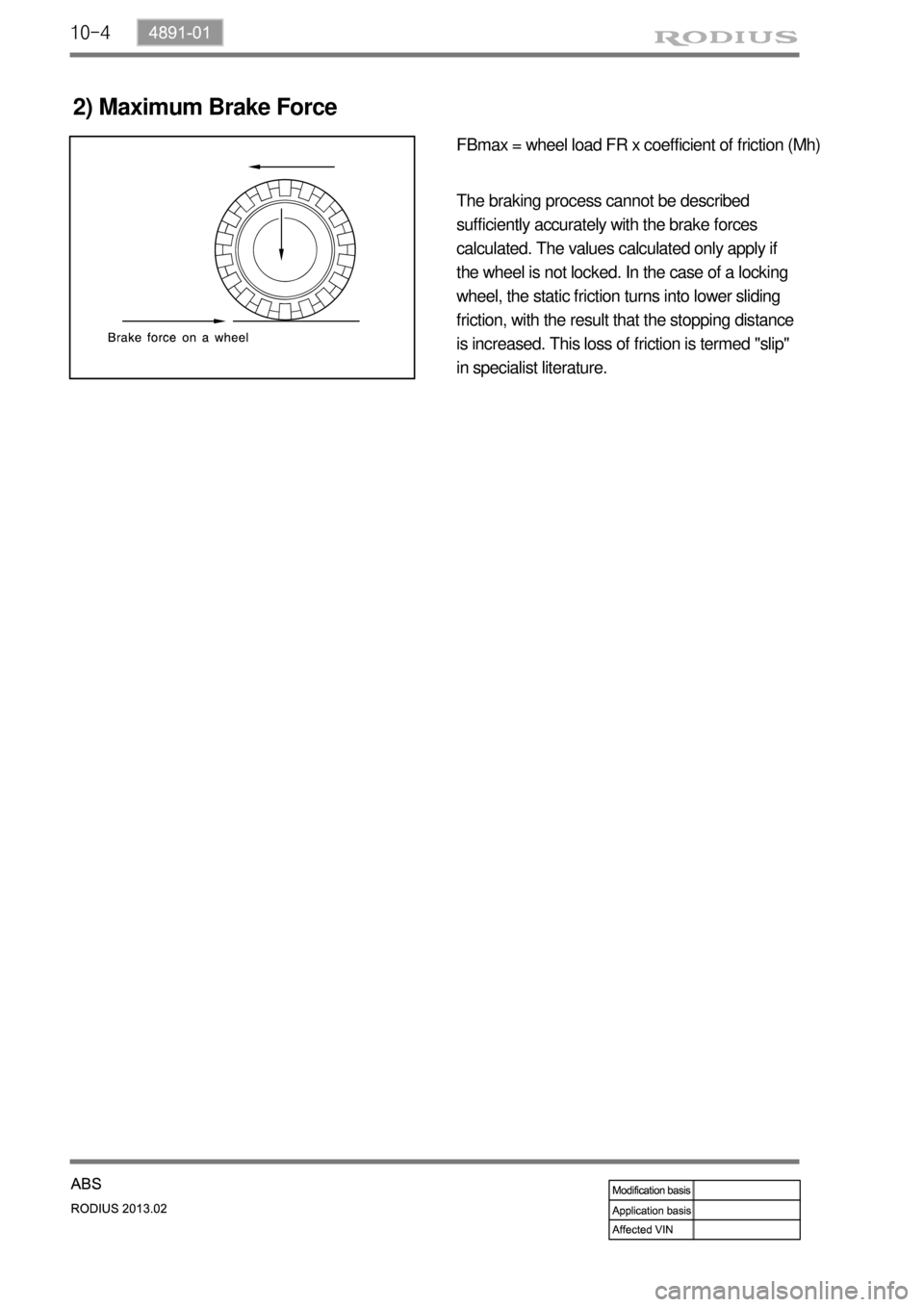
10-4
2) Maximum Brake Force
FBmax = wheel load FR x coefficient of friction (Mh)
The braking process cannot be described
sufficiently accurately with the brake forces
calculated. The values calculated only apply if
the wheel is not locked. In the case of a locking
wheel, the static friction turns into lower sliding
friction, with the result that the stopping distance
is increased. This loss of friction is termed "slip"
in specialist literature.
Page 679 of 796

10-6
3. ABS SYSTEM OPERATION
1) Block Diagram
Page 682 of 796
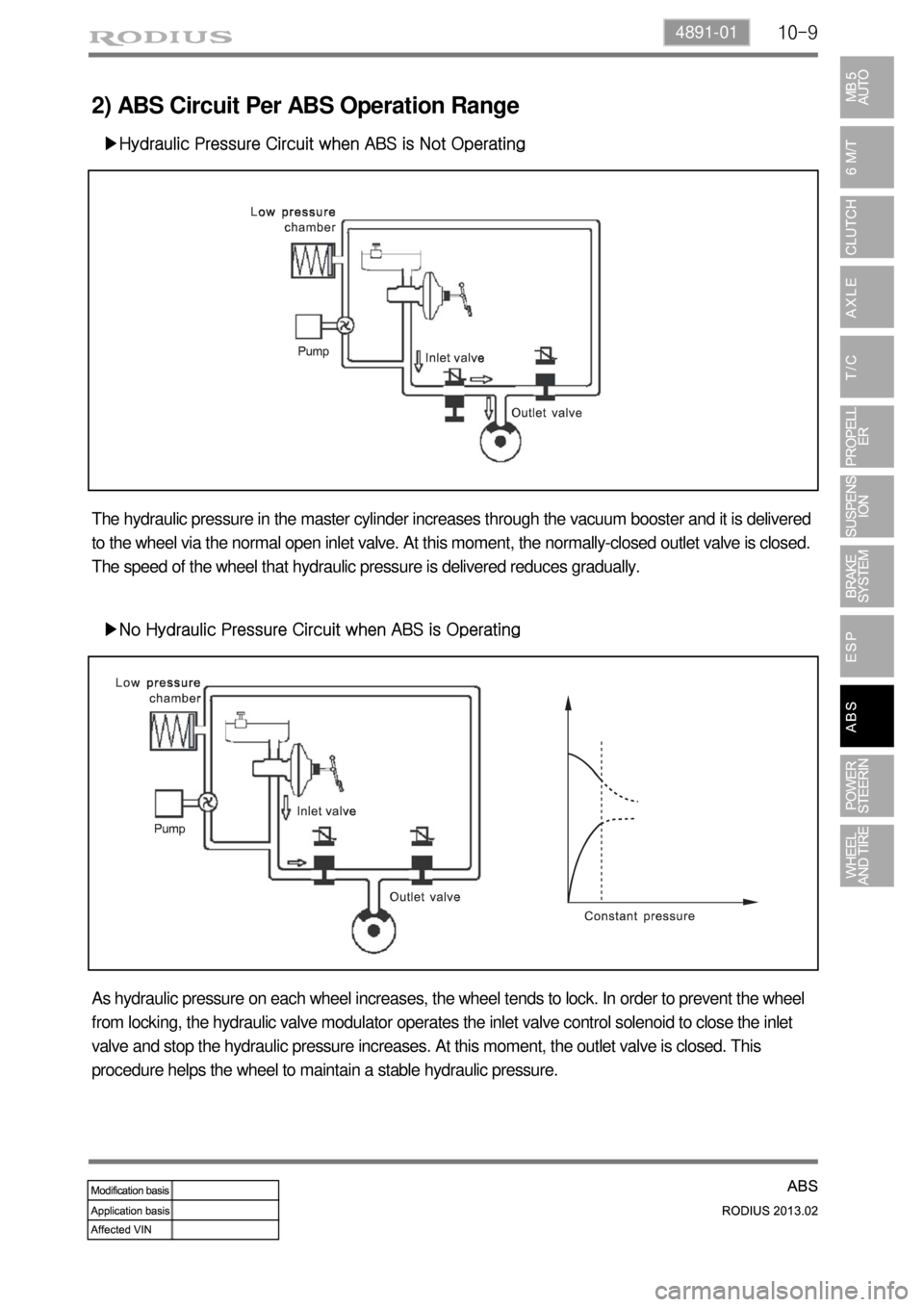
10-94891-01
2) ABS Circuit Per ABS Operation Range
▶Hydraulic Pressure Circuit when ABS is Not Operating
The hydraulic pressure in the master cylinder increases through the vacuum booster and it is delivered
to the wheel via the normal open inlet valve. At this moment, the normally-closed outlet valve is closed.
The speed of the wheel that hydraulic pressure is delivered reduces gradually.
▶No Hydraulic Pressure Circuit when ABS is Operating
As hydraulic pressure on each wheel increases, the wheel tends to lock. In order to prevent the wheel
from locking, the hydraulic valve modulator operates the inlet valve control solenoid to close the inlet
valve and stop the hydraulic pressure increases. At this moment, the outlet valve is closed. This
procedure helps the wheel to maintain a stable hydraulic pressure.
Page 683 of 796
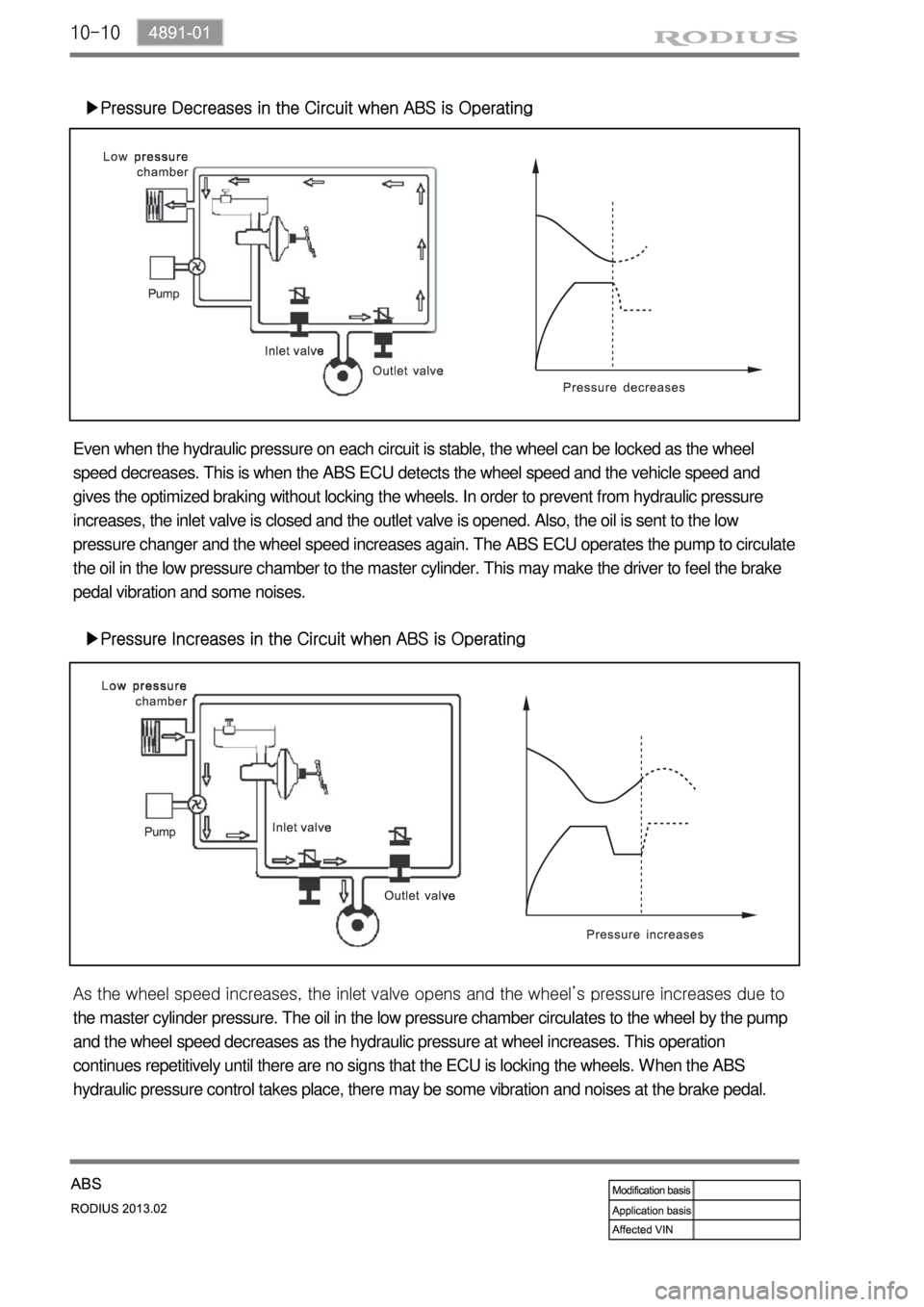
10-10
▶Pressure Decreases in the Circuit when ABS is Operating
Even when the hydraulic pressure on each circuit is stable, the wheel can be locked as the wheel
speed decreases. This is when the ABS ECU detects the wheel speed and the vehicle speed and
gives the optimized braking without locking the wheels. In order to prevent from hydraulic pressure
increases, the inlet valve is closed and the outlet valve is opened. Also, the oil is sent to the low
pressure changer and the wheel speed increases again. The ABS ECU operates the pump to circulate
the oil in the low pressure chamber to the master cylinder. This may make the driver to feel the brake
pedal vibration and some noises.
▶Pressure Increases in the Circuit when ABS is Operating
As the wheel speed increases, the inlet valve opens and the wheel’s pressure increases due to
the master cylinder pressure. The oil in the low pressure chamber circulates to the wheel by the pump
and the wheel speed decreases as the hydraulic pressure at wheel increases. This operation
continues repetitively until there are no signs that the ECU is locking the wheels. When the ABS
hydraulic pressure control takes place, there may be some vibration and noises at the brake pedal.